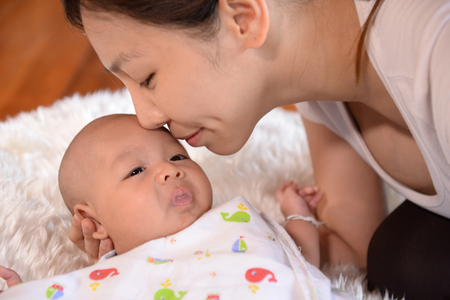1. The Importance of Social Interaction in Early Language Development
From the moment they are born, infants begin their journey of language development through social interactions. Babies are naturally inclined to listen to voices, observe facial expressions, and respond to sounds. These early exchanges lay the foundation for communication skills that will shape their ability to understand and use language effectively.
How Infants Learn Through Interaction
Infants do not acquire language in isolation. Instead, they rely on engaging with caregivers and others around them to develop communication skills. When a caregiver talks, sings, or responds to a baby’s cooing sounds, it reinforces the connection between sounds and meaning. This back-and-forth interaction is crucial for language learning.
The Role of Caregivers in Language Development
Caregivers play an essential role in fostering language development by providing consistent verbal and nonverbal cues. Some key ways caregivers support language growth include:
| Interaction Method | How It Helps Language Development |
|---|---|
| Talking to the Baby | Exposes infants to new words and sentence structures. |
| Using Facial Expressions and Gestures | Helps babies connect emotions with words. |
| Singing Songs and Nursery Rhymes | Enhances memory and rhythm recognition. |
| Reading Books Aloud | Introduces new vocabulary and storytelling patterns. |
| Responding to Baby’s Sounds | Encourages turn-taking in conversations. |
The Power of Responsive Communication
A crucial element of social interaction in language development is responsiveness. When caregivers respond promptly and enthusiastically to a babys babbling or gestures, it encourages the child to continue communicating. This positive reinforcement strengthens neural connections related to speech and comprehension.
2. The Role of Parents and Caregivers in Language Acquisition
Parents and caregivers play a crucial role in shaping an infants language development. Through daily interactions, they provide the foundation for communication skills that children will use throughout their lives. One of the most effective ways parents support language learning is through infant-directed speech and responsive communication.
Infant-Directed Speech: Why It Matters
Infant-directed speech (IDS), often called “parentese,” is a special way that adults naturally talk to babies. It includes exaggerated pitch, slower tempo, and clearer pronunciation. Research shows that IDS helps infants focus on speech sounds, making it easier for them to recognize words and patterns in language.
Key Features of Infant-Directed Speech
| Feature | Description |
|---|---|
| Higher Pitch | Makes speech more engaging and easier for infants to hear. |
| Slower Tempo | Gives babies more time to process words and sounds. |
| Exaggerated Intonation | Highlights important words and emotions. |
| Simplified Sentences | Makes it easier for infants to understand basic language structures. |
The Power of Responsive Communication
A key factor in language learning is how parents respond to their babys vocalizations and gestures. When caregivers acknowledge and react to a baby’s coos, babbles, or attempts at words, they reinforce the idea that communication is meaningful.
Ways to Practice Responsive Communication
- Mimicking Sounds: Repeating your baby’s sounds encourages them to keep practicing speech.
- Narrating Activities: Describing what youre doing (“Now we’re putting on your shoes!”) helps babies connect words with actions.
- Praising Attempts: When babies try new words, positive reinforcement motivates them to continue learning.
- Taking Turns: Treating conversations like a back-and-forth exchange teaches babies the rhythm of dialogue.
The Impact of Everyday Interactions
The way parents interact with their infants every day has lasting effects on their language abilities. Simple activities like reading books, singing songs, and talking during routine tasks all contribute to a child’s vocabulary growth and comprehension skills. By engaging in meaningful conversations from an early age, caregivers help lay the groundwork for strong communication skills in the future.

3. How Peer Interaction Shapes Communication Skills
Infants learn not only from their parents and caregivers but also from their interactions with siblings and other children. These peer interactions play a crucial role in shaping both social and linguistic abilities. When babies observe and engage with other kids, they pick up new words, gestures, and social cues that help them build communication skills.
The Role of Sibling Interaction
Siblings often serve as early conversation partners for infants. Older siblings naturally talk to and play with younger ones, providing exposure to language in a more informal way than adult interactions. This dynamic helps infants develop turn-taking skills, understand tone variations, and expand their vocabulary.
Benefits of Sibling Interactions in Language Development
| Benefit | Description |
|---|---|
| Increased Vocabulary | Younger siblings learn new words by listening to their older brothers or sisters. |
| Better Social Skills | Frequent sibling interactions teach infants about cooperation and sharing. |
| Improved Listening Abilities | Siblings expose infants to different speech patterns and tones, enhancing comprehension. |
| More Practice with Conversations | Siblings engage in back-and-forth exchanges that improve an infant’s ability to communicate. |
The Impact of Playgroups and Peer Interaction
Apart from siblings, interacting with other children in daycare, playgroups, or playgrounds provides valuable learning experiences. These social settings encourage infants to experiment with sounds, gestures, and words while engaging with peers.
How Peer Interaction Enhances Communication Skills
- Mimicry: Babies often imitate the speech patterns and actions of other children, helping them practice language skills.
- Taking Turns: Playing with peers teaches infants the fundamental rule of conversations—taking turns to speak.
- Diverse Language Exposure: Being around different children exposes infants to varied ways of speaking, broadening their understanding of language.
- Problem-Solving Through Communication: Babies learn how to express their needs and resolve minor conflicts through verbal and non-verbal cues.
The Influence of Social Environment on Speech Development
The more opportunities an infant has to interact with peers, the faster they develop communication skills. Engaging in group activities encourages infants to listen attentively, respond appropriately, and refine their ability to express themselves clearly.
4. The Impact of Cultural and Social Environment on Infant Language Development
Infants learn language not just by hearing words but by engaging with the people around them. The cultural norms and social settings they experience play a big role in shaping how they acquire and use language. Different cultures have unique ways of communicating with infants, and these differences can influence language development in various ways.
The Role of Cultural Norms in Language Learning
Cultural norms determine how caregivers interact with infants, affecting their exposure to language. Some cultures emphasize direct verbal communication, while others rely more on nonverbal cues and contextual learning.
| Cultural Approach | Language Exposure | Impact on Development |
|---|---|---|
| Western cultures (e.g., U.S., U.K.) | Frequent direct conversations, baby talk (infant-directed speech) | Encourages early verbal expression and vocabulary growth |
| Eastern cultures (e.g., Japan, China) | More indirect communication, focus on listening and observation | Develops strong contextual understanding and listening skills |
| Indigenous communities | Language learned through immersion in daily activities | Promotes learning through observation and participation |
Social Settings That Influence Language Development
The environment where an infant grows up also affects their ability to learn language. Factors such as family structure, community involvement, and access to social interactions shape how children develop communication skills.
Family Interaction Styles
Some families engage in frequent conversations with their infants, while others may have quieter households where communication happens less often. Homes where multiple languages are spoken can also influence bilingualism from an early age.
Community and Social Engagement
Infants who grow up in socially active environments—such as those with extended family members, daycare settings, or community gatherings—tend to develop strong communication skills early on. Social exposure provides them with more opportunities to practice listening and speaking.
The Importance of Responsive Communication
No matter the cultural background or social setting, one key factor in language development is responsive communication. When caregivers respond to an infant’s sounds and gestures with meaningful interaction, it strengthens their ability to learn language naturally.
Understanding how cultural and social environments shape infant language development helps caregivers create supportive learning experiences tailored to their childs needs. By embracing these influences, parents can foster effective communication skills that will benefit their child for life.
5. Technology and Its Influence on Social Language Learning
In todays digital age, technology plays a significant role in shaping how infants interact with their surroundings. With the rise of smartphones, tablets, and smart devices, many parents wonder how digital media impacts their childs language development. While technology offers new learning opportunities, it also raises concerns about reduced face-to-face social interactions.
How Digital Devices Affect Infant Social Interactions
Infants learn language primarily through social interactions. Conversations with caregivers, facial expressions, and gestures all contribute to a babys understanding of communication. However, when screens replace human interaction, these essential elements may be reduced.
Comparing Traditional vs. Digital Interaction
| Aspect | Traditional Interaction | Digital Interaction |
|---|---|---|
| Language Exposure | Direct conversations with caregivers help infants learn words naturally. | Screen-based exposure can introduce new vocabulary but lacks real-time responses. |
| Social Cues | Babies learn through eye contact, tone of voice, and facial expressions. | Screens do not provide direct engagement or emotional feedback. |
| Cognitive Development | Interactive play encourages problem-solving and creativity. | Passive screen time may limit interactive learning experiences. |
The Role of Interactive Media in Language Learning
Not all technology use is harmful. Some digital tools, such as interactive story apps or educational videos that encourage participation, can support language learning. The key is to use technology as a supplement rather than a replacement for human interaction.
Best Practices for Using Technology with Infants
- Co-viewing: Engage with your baby while using digital media by talking about what they see.
- Limiting Screen Time: Follow expert guidelines to ensure screen exposure is age-appropriate.
- Encouraging Active Participation: Choose apps or programs that require interaction rather than passive watching.
- Prioritizing Human Interaction: Use technology to enhance, not replace, face-to-face communication.
Finding Balance Between Technology and Social Interaction
The best approach is a balanced one—technology can be a useful tool when used mindfully. By combining traditional social interactions with thoughtfully chosen digital resources, parents can help their infants develop strong language skills while adapting to the modern world.


